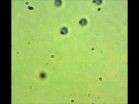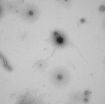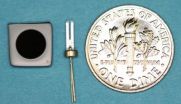(Press-News.org) Further analysis of a Phase II study of therapeutic HIV vaccine candidate Vacc-4x revealed a potential biomarker associated with participants who experienced a more profound viral load reduction after receiving the vaccine. The results of this exploratory, ad hoc, subset analysis by St George's, University of London and Bionor Pharma were announced today at the AIDS 2014 Conference in Melbourne, Australia.
If confirmed, the biomarker may be able to predict which patients will benefit most from the therapeutic HIV vaccine candidate Vacc-4x, which is being developed by the Norwegian vaccine company Bionor Pharma.
St George's, University of London has had a long-standing collaboration with Bionor Pharma in a project to study HIV-associated immune activation that drives disease progression. Based on St George's work within this field, Bionor Pharma has developed a peptide (C5/gp41732-744 ) that can be used to detect antibodies against a part of the HIV envelope glycoprotein. The presence of antibodies to this part of HIV has been associated with slowed disease progression in the absence of combination antiretroviral therapy (ART).
Analysis of antibody responses to C5/gp41732-744 among patients who participated in a large Phase II clinical study has revealed that participants with baseline anti-C5/gp41732-744 antibody levels above 4μg/ml who received Vacc-4x had a statistically significant reduction in median viral load setpoint of log 0.94 (88%) compared to their median pre-ART viral load setpoint (p=0.005, n=12). Participants with anti-C5/gp41732-744 antibody levels below 4μg/ml who received Vacc-4x had a median viral load reduction of log 0.20 or 37% (p=0.019, n=27) compared to their median pre-ART viral load setpoint. The earlier Phase II study on which this subset analysis was based found a statistically significant 60% reduction in median viral load setpoint compared to historic viral load levels among participants who received Vacc-4x, interrupted ART for six months, and had pre-ART viral load data available. In contrast, those who received placebo did not experience a statistically significant change in viral load compared to pre-ART viral load setpoint.
Therapeutic HIV vaccines are designed to train the immune system to seek out and kill virus-producing cells in order to control the patient's HIV for prolonged periods of time. A successful therapeutic vaccine may negate the need for daily antiretroviral therapy (ART) for some people with HIV or provide an option for those who do not respond to ART.
Professor Angus Dalgleish, of St George's, University of London, said: "In spite of very effective drugs against HIV these need to be taken daily and have significant side-effects.
"The ability to replace this daily medication with a vaccine that allows several months of being off medication, not to mention the enormous financial gains that would be delivered to health services, is a step closer with these preliminary results."
Further study will be needed to confirm anti-C5/gp41732-744 antibody levels as a biomarker for improved response to Vacc-4x. Approximately 21% of participants in the Phase II study had antibody levels above 4µg/ml prior to Vacc-4x vaccination.
Vacc-4x is also being studied in a clinical trial to assess whether a 'kick-kill' strategy, which is designed to reverse HIV latency using HDAC inhibitor romidepsin and to train the immune system to kill virus-producing cells using Vacc-4x, may be effective in reducing the HIV reservoir.
INFORMATION:
About Vacc-4x
Vacc-4x is designed as a therapeutic HIV vaccine candidate aimed at generating immune responses to "conserved domains", or parts of HIV that are consistently present, even if the virus mutates. Sustained immune responses to this part of the virus (on the HIV protein p24) have been shown to delay HIV disease progression. Vacc-4x, which is being developed by Bionor Pharma, is made from modified, synthetic peptides, targeting these conserved regions on HIV p24. By immunizing with Vacc-4x, potentially followed by reboosting immunizations, researchers seek to control the virus infection for a prolonged period of time by training the patient's own immune system to seek out and kill virus-producing cells.
About the Phase II Vacc-4x clinical trial
The study was a Phase II randomized, multicenter, double-blind, placebo-controlled multinational clinical trial of Vacc-4x. The trial enrolled 137 participants and was conducted at clinical trial sites in the UK, the US, Germany, Italy and Spain between July 2008 and June 2010. The 52-week follow-up period was completed in June 2011. The study is registered with Clinicaltrials.gov with the identifier NCT00659789 and was published in The Lancet Infectious Diseases 2014; 14: 291-300. For study participants who completed a six-month treatment interruption of ART, there was a 64% reduction in median viral load set point between the two groups, which was statistically significant (Vacc-4x 22300 copies/mL, n=56; and placebo 61900 copies/mL, n=25; p=0.040) corresponding to a 0.44 log reduction. For participants with a pre-ART value available, a reduction in the median viral load set point of 0.40 log compared to pre-ART values was observed (24150 compared to 60470 copies/mL, p=0.0001) in the Vacc-4x group (n=45). This result was in contrast to the placebo group, in which no reduction was observed (n=18) (50400 compared to 52731 copies/mL, log 0.02, p=0.980).
About St George's, University of London
St George's, University of London, is the UK's only university dedicated to medical and health sciences education, training and research. Sharing a clinical environment with a major London teaching hospital, our innovative approach to education results in well-rounded, highly skilled clinicians, scientists, and health and social care professionals.
Our internationally recognised research programme delivers cutting-edge scientific discovery through three specialist Research Institutes, directly helping patients through our close links to the clinical frontline and London's diverse community.
Our Institutes focus on biomedical and scientific discovery, advancing the prevention and treatment of disease in the fields of population health, heart disease and infection – three of the greatest challenges to global health in the 21st Century.
Biomarker discovery may lead to new HIV treatment
Median HIV viral load reduction more than doubled among participants with high anti-C5/gp41732-744 antibody levels who received therapeutic HIV vaccine candidate Vacc-4x in exploratory, ad hoc, subset analysis by St George's and Bionor Pharma
2014-07-18
ELSE PRESS RELEASES FROM THIS DATE:
'Nanocamera' takes pictures at distances smaller than light's own wavelength
2014-07-17
VIDEO:
This is a video demonstrating scanning-stage-based exposure, whereby programmed
motion of a microscope stage is used to write the University's "Block I " logo into the plasmonic film. Each bar in the...
Click here for more information.
Researchers at the University of Illinois at Urbana-Champaign have demonstrated that an array of novel gold, pillar-bowtie nanoantennas (pBNAs) can be used like traditional photographic film to record light for distances that ...
Tiniest catch: University of Arizona scientists' fishing expedition reveals viral diversity in the sea
2014-07-17
A fishing expedition of microscopic proportions led by University of Arizona ecologists revealed that the lines between virus types in nature are less blurred than previously thought.
Using lab-cultured bacteria as "bait," a team of scientists led by Matthew Sullivan has sequenced complete and partial genomes of about 10 million viruses from an ocean water sample in a single experiment.
The study, published online on July 14 by the journal Nature, revealed that the genomes of viruses in natural ecosystems fall into more distinct categories than previously thought. This ...
Lunar pits could shelter astronauts, reveal details of how 'man in the moon' formed
2014-07-17
VIDEO:
This video shows images from NASA's LRO spacecraft of various lunar pits.
Click here for more information.
While the moon's surface is battered by millions of craters, it also has over 200 holes – steep-walled pits that in some cases might lead to caves that future astronauts could explore and use for shelter, according to new observations from NASA's Lunar Reconnaissance Orbiter (LRO) spacecraft.
The pits range in size from about 5 meters (~5 yards) across to more than ...
Older adults who walk out of necessity are at highest risk for outdoor falls
2014-07-17
Older adults are at a greater danger of falling when walking for utilitarian purposes such as shopping and appointments than when walking for recreation, according to a study from UMass Medical School.
"Older adults have two times the risk of falling while walking out of necessity than walking for recreation, and four times greater risk of injury from a fall on a sidewalk than in a recreational area," said Wenjun Li, PhD, associate professor of medicine in the Division of Preventive and Behavioral Health at UMMS and lead author of the study "Utilitarian Walking, Neighborhood ...
Estimating earthquake frequency and patterns in the Puget Lowland
2014-07-17
Boulder, Colo. - The hazard posed by large earthquakes is difficult to estimate because they often occur hundreds to thousands of years apart. Because written records for the Puget Lowland of northwestern Washington cover less than 170 years, the size and frequency of the largest and oldest earthquakes on the Seattle and Tacoma faults are unknown. Past earthquakes can only be estimated through geologic studies of sediments and landforms that are created when faults break the ground surface.
Along the Cascadia margin, the cities of Seattle and Tacoma occupy the Puget ...
Discovery may make it easier to develop life-saving stem cells
2014-07-17
Not unlike looking for the proverbial needle in a haystack, a team of Michigan State University researchers have found a gene that could be key to the development of stem cells – cells that can potentially save millions of lives by morphing into practically any cell in the body.
The gene, known as ASF1A, was not discovered by the team. However, it is at least one of the genes responsible for the mechanism of cellular reprogramming, a phenomenon that can turn one cell type into another, which is key to the making of stem cells.
In a paper published in the journal Science, ...
Losing sleep over your divorce? Your blood pressure could suffer
2014-07-17
Those who experience persistent sleep problems after a divorce stand to suffer from more than just dark circles. They might also be at risk for potentially harmful increases in blood pressure, a new study finds.
A growing body of research links divorce to significant negative health effects and even early death, yet few studies have looked at why that connection may exist.
Divorce-related sleep troubles may be partly to blame, suggest the authors of a new study to be published in a forthcoming issue of the journal Health Psychology.
"In the initial few months after ...
Choosing cheese
2014-07-17
Go ahead and call Rachel Dutton's research cheesy if you must. As far as she's concerned, it's anything but an insult.
A Bauer Fellow at the Faculty of Arts and Sciences' Center for Systems Biology, Dutton and her lab study cheese – or more precisely – the bacteria and fungi that live on cheese, in an effort to better understand how microbial communities form.
After studying 137 varieties of cheese collected in 10 different countries, Dutton has been able to identify three general types of microbial communities that live on cheese, opening the door to using each as ...
Future electronics may depend on lasers, not quartz
2014-07-17
Nearly all electronics require devices called oscillators that create precise frequencies—frequencies used to keep time in wristwatches or to transmit reliable signals to radios. For nearly 100 years, these oscillators have relied upon quartz crystals to provide a frequency reference, much like a tuning fork is used as a reference to tune a piano. However, future high-end navigation systems, radar systems, and even possibly tomorrow's consumer electronics will require references beyond the performance of quartz.
Now, researchers in the laboratory of Kerry Vahala, the ...
Exploiting gastric vulnerability
2014-07-17
Helicobacter pylori infection promotes stomach ulcers and cancer. How H. pylori initially interacts with and irritates gastric tissue is not well understood. An article published on July 17th in PLOS Pathogens now describes that H. pylori rapidly identifies and colonizes sites of minor injuries in the stomach, almost immediately interferes with healing at those injury sites, and so promotes sustained gastric damage.
Smoking, alcohol, excessive salt intake, and non-steroidal anti-inflammatory drugs cause damage to the tissue lining the stomach, and are associated with ...
LAST 30 PRESS RELEASES:
Numbers in our sights affect how we perceive space
SIMJ announces global collaborative book project in commemoration of its 75th anniversary
Air pollution exposure and birth weight
Obstructive sleep apnea risk and mental health conditions among older adults
How talking slows eye movements behind the wheel
The Ceramic Society of Japan’s Oxoate Ceramics Research Association launches new international book project
Heart-brain connection: international study reveals the role of the vagus nerve in keeping the heart young
Researchers identify Rb1 as a predictive biomarker for a new therapeutic strategy in some breast cancers
Survey reveals ethical gaps slowing AI adoption in pediatric surgery
Stimulant ADHD medications work differently than thought
AI overestimates how smart people are, according to HSE economists
HSE researchers create genome-wide map of quadruplexes
Scientists boost cell "powerhouses" to burn more calories
Automatic label checking: The missing step in making reliable medical AI
Low daily alcohol intake linked to 50% heightened mouth cancer risk in India
American Meteorological Society announces Rick Spinrad as 2026 President-Elect
Biomass-based carbon capture spotlighted in newly released global climate webinar recording
Illuminating invisible nano pollutants: advanced bioimaging tracks the full journey of emerging nanoscale contaminants in living systems
How does age affect recovery from spinal cord injury?
Novel AI tool offers prognosis for patients with head and neck cancer
Fathers’ microplastic exposure tied to their children’s metabolic problems
Research validates laboratory model for studying high-grade serous ovarian cancer
SIR 2026 delivers transformative breakthroughs in minimally invasive medicine to improve patient care
Stem Cell Reports most downloaded papers of 2025 highlight the breadth and impact of stem cell research
Oxford-led study estimates NHS spends around 3% of its primary and secondary care budget on the health impacts of heat and cold in England
A researcher’s long quest leads to a smart composite breakthrough
Urban wild bees act as “microbial sensors” of city health.
New study finds where you live affects recovery after a hip fracture
Forecasting the impact of fully automated vehicle adoption on US road traffic injuries
Alcohol-related hospitalizations from 2016 to 2022
[Press-News.org] Biomarker discovery may lead to new HIV treatmentMedian HIV viral load reduction more than doubled among participants with high anti-C5/gp41732-744 antibody levels who received therapeutic HIV vaccine candidate Vacc-4x in exploratory, ad hoc, subset analysis by St George's and Bionor Pharma





